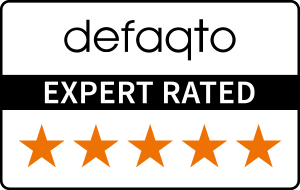Who Are The People’s Pension?
The People’s Pension is run by People’s Partnership, a not-for-profit organisation. Founded in 1942, it has been providing pension schemes for over 35 years.
![The Peoples Pension 5 Star Defaqto Rating Logo]()
The People’s Pension started with a holiday savings scheme for the construction industry. It then went on to deliver products that were simple to implement, beneficial for workers, and hassle-free for employers.
Over 100,000 businesses work with The People’s Pension, with over 5 million members.
The People’s Pension Overview
The People’s Pension is one of the UK’s largest group defined contribution auto-enrolment workplace schemes. It’s available to employers of any size and industry. It is operated by B&CE and has so far accrued more than 4.9 million individual investors.
Which Employers Might Consider The People’s Pension Workplace Scheme?
This scheme is available to employers who need to meet their pension obligations. However, while it is open to all employers regardless of their size, smaller businesses may find it more beneficial.
To be eligible for automatic enrolment, employees must:
- Be over 22 years old but below State Pension Age
- Work in the UK
- Not be in a qualifying workplace pension already
- Have an employment contract
- Earn over the required minimum amount.
Non-eligible employees can still ask their employer if they can join the scheme.
How Does The People’s Pension Workplace Scheme Work?
It can be used by multiple employers, which is why it’s known as a master trust or multi-employer pension scheme.
It’s a defined contribution pension for employers and employees to pay into. Contributions are a percentage of the employee’s qualifying earnings.
Sign Up Options
The People’s Pension has two sign-up options depending on the employer’s payment needs:
- Simply Comply
This option is for employers who pay their workers monthly or weekly
- Simply Tailor
For employers who need a more personalised approach and pay different amounts to employees.
Contributions are managed on behalf of the employee by the independent trustees. While the trustees will make all the major decisions, employers can decide on:
- How much they will contribute to their employees’ pension pot
- Contribution limits
- How investments are made.
Who Can Contribute To The Scheme?
Your staff will pay contributions to their pension, along with you as their employer. The government will also make a contribution in the form of tax relief.
It’s important to note that the employee and employer must pay the minimum contributions set out by law. But if either party wants to increase their contributions, they are free to do this.
Most people who join The People’s Pension do so after being automatically-enrolled by their employer. They can also join if they’ve received a share of their ex-partner’s pension fund via a divorce settlement.
IMPORTANT NOTICE 🧐
Unlike other providers, The People’s Pension is not available to self-employed individuals to meet their own pension requirements.
What Are The People’s Pension Charges?
The People’s Pension has the following fees:
- Annual Charge
Employees will be charged £2.50 at the end of the scheme year
- Management Charge
A 0.5% fee applies to the employee’s pension pot value each year. This is the equivalent of 50p a year for each £100 in the employee’s pension pot
- Rebate
Members can receive a management charge rebate of 0.1% to 0.3%, depending on how much is in their pension.
How Much Can Be Paid Into A People’s Pension Scheme?
While employers and employees contribute, the amount they pay depends on the following.
Employee Pension Contributions
Employees pay a percentage of their earnings into the scheme. The government states that they must pay a minimum of 5% of their qualifying income.
These contributions are deducted from the employee’s salary before tax each month. Doing so enables employees to receive tax relief on the savings they’ve made via their pension. As a result of this, although they pay 5%, the government will actually pay 1% out of the 5% as tax relief.
Employees can make a larger pension contribution than 5%. However, the maximum amount will be determined by the employee’s annual allowance or the limits set by the employer, whichever is lower.
Employer Pension Contributions
Besides the 5% employees pay to their pension each month, employers also contribute at least 3%. This takes the minimum contributions to 8% of an employee’s qualifying income (4% employee, 3% employer, and 1% tax relief).
Employers can contribute more than 3%. Some choose to offer higher pension contributions as part of their employee benefits package.
When Can Employees Access Their Pension Fund?
An employee can access their fund when they turn 55 years old. Once they reach their 55th birthday, they can withdraw 25% of their savings as a tax-free lump sum.
They can also choose to leave the savings in the pot if they prefer to have more available later.
Can Employees Transfer Other Pension Pots Into The Scheme?
Employees can transfer other pensions they have to The People’s Pension on their online account. The good news? There’s no charge for doing so.
Employees can also transfer out of The People’s Pension plan. This is as long as the new pension provider accepts transfers and has the appropriate HMRC scheme reference.
What Happens If An Employee Leaves?
When an employee leaves their job, they should be marked as having left employment. The employer will no longer make contributions to that employee’s pension pot. The employee can continue to contribute privately to their People’s Pension fund after leaving, though.
Where Do Contributions To The People’s Pension Get Invested?
There are eight investment funds to choose from. When first enrolled in the scheme, pension contributions automatically go into the default ‘balanced’ fund with a low level of risk.
The People’s Pension Funds
The People’s Pension offers various investment choices with a mixture of shares, bonds, and gilts. An employee’s money is invested across the different funds based on their choice, and how near they are to retirement.
For proactive investors, there are eight funds they can choose from:
- Ethical Growth Fund
- Shariah Fund
- Global Investments (at three different levels)
- Pre-Retirement Fund
- Annuity
- Cash.
The People’s Pension Risk Fund Profiles
Each type of pension fund has a different degree of risk. Employees can move their pension savings into a fund that best suits their risk preference. They can also choose how much of their pension savings to put in each fund.
There are three investment profiles to choose from:
Balanced
This investment profile contains equities or shares, property, gilts, and corporate bonds. Most of this is invested in equities and divided into:
- 7% infrastructure
- 7% property
- 20% corporate bonds and gilts
- 66% equities.
Cautious
This investment profile has a lower risk and features more corporate bonds and gilts, and fewer equities or shares. It is divided into:
- 40% corporate bonds and gilts
- 60% equities or shares.
Adventurous
This investment profile offers the most risk. The entire fund comprises equities or shares. If an employee chooses this fund, savings would be invested into:
- Asia Pacific shares – 12.5%
- Japanese shares – 12.5%
- European shares – 25%
- UK shares – 25%
- US shares – 25%.
Who Manages The Peoples Pension Investment Funds?
Once an employee contributes to a People’s Pension investment fund, it is managed by the schemes board of trustees. The trustees are responsible for investing the savings and making decisions that will have the best impact on returns.
The trustees delegate the day-to-day management of investments to professional investment managers who have extensive experience in the investment market.
Is The People’s Pension The Same As A State Pension?
No. It is separate from the state pension. State pensions are provided by the government once you reach retirement age and are funded by taxpayers, instead of employees and their employers.
Can Employees Opt Out Of The People’s Pension Workplace Scheme?
Yes, after an employee has been enrolled in The People’s Pension, they can leave at any time if they wish. If they opt out, they will miss out on the extra free money their employer and the government put towards their pot.
What Happens To The People’s Pension If An Employee Dies?
When an employee joins the scheme, they will nominate a beneficiary whom they’d like to receive their pension if they were to die. The People’s Pension trustee will then consider the employee’s wishes after they’ve gone.
Is The People’s Pension Worth It?
When you choose a workplace pension scheme for your employees, there are several factors to consider. A good place to start is by reviewing its advantages and disadvantages.
Advantages
Low Cost For Employees
Unlike other defined contribution schemes, employees won’t have to pay a contribution charge on their savings.
Three Lifestyle Profiles
Employees can pick from one of the three lifestyle risk profiles that best suits them: cautious, balanced, and adventurous. They also have the option to move between funds up to twice a year at no charge.
Continue Contributions After Employee Leaves Job
An employee can continue contributing to The People’s Pension scheme even after they’ve left their current job.
Good Support
The People’s Pension offers useful tools to help employers communicate with their employees about the scheme. An assessment template enables employers to assess their workforce and upload employee details each pay period.
Disadvantages
Set-Up Fee For Employers
Unlike other pensions, The People’s Pension charges employers a one-off £500 fee for setting up the scheme. But employers can reduce this to £300 if they use an adviser to set it up.
Annual Management Charge For Employees
Employees must pay a 0.5% management fee on their savings.
When it comes to selecting a workplace pension scheme, it is important to shop around and compare providers as fees and charges will vary depending on who you choose.
Best Alternatives To The People’s Pension Workplace Pension Scheme
Before deciding which workplace pension is right for your staff, it’s always a good idea to compare providers.
Each pension provider has different tax relief models and eligibility criteria. Researching the providers can help to find the one that best measures up against your needs.
Alternative Workplace Pension Providers
- Aegon
- Aviva
- Nest
- NOW: Pensions
- Royal London
- Scottish Widows.
Our specialist in-depth review of each of the UK's leading corporate pension providers
Compare Workplace Pension Schemes & Get Specialist Advice
Choosing the right workplace pension for your company is a huge responsibility. With lots of options available, it can seem a daunting task. But fortunately, we are here to take the stress out of setting up a new workplace pension.
If you’d like some guidance from our team, don’t hesitate to contact us on 02074425880 or email at help@drewberry.co.uk.
Why Speak to Us?
Employee benefits can be a headache. But our specialists do this day-in, day-out, offering first class service when you need it most. Here’s why you should talk to us:
- Award-winning independent employee benefits consultants, working with leading UK insurers and benefit providers
- Assigned specialist on hand to help – every step of the way
- 4066 and growing independent client reviews rating us at 4.92 / 5
- Authorised and regulated by the Financial Conduct Authority. Find us on the financial services register
- Claims support when you need it most.


















